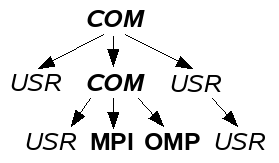
A TRACING region indicates intermediate trace buffer flushing to file, as well as measurement initialization and finalization (including clock offset determination) even when tracing is disabled.
A PAUSING region marks when measurement was explicitly paused via EPIK user API macros. Events are not recorded while measurement is paused.
A special PARALLEL region is synthesized to encapsulate MPI regions if an MPI region is the first to be encountered. It defines the parallel execution between MPI_Init (or MPI_Init_thread) and MPI_Finalize.
A special UNKNOWN region can also appear in measurements and is used to indicate various problems, such as failure to determine the actual name of a routine or truncation of the call-tree due to insufficient capacity.
MPI regions cannot be filtered (like user-level regions), however, sets of regions which are not desired in a measurement can be disabled by eliminating them from the EPK_MPI_ENABLED specification in EPIK.CONF or as an environment variable. Execution time in uninstrumented or disabled MPI routines will appear attributed to the calling user-level routine.
OMP regions cannot be filtered (like user-level regions) during measurement, however, source files containing OpenMP can be instrumented selectively. Furthermore, OPARI2 can be configured to disable instrumentation of some or all of the more fine-grained OpenMP constructs atomic, critical, flush, locks, master and single.
If the frequent execution of a routine results in substantial overhead (either through measurement dilation or trace buffer capacity), consider specifying its name in a filter used for subsequent measurements, or apply selective instrumentation (e.g., via the PDT instrumenter).

 |
Copyright © 1998-2013 Forschungszentrum Jülich GmbH |